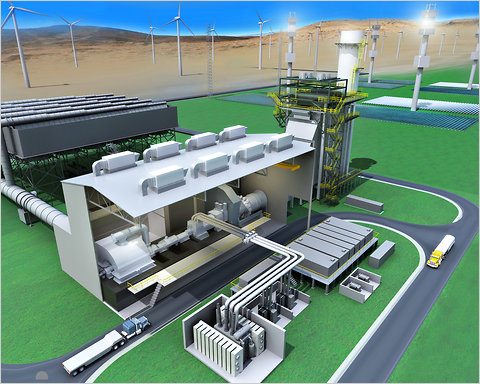
Traditional power plant operators have been loathe to adopt renewables for infrastructure investment. But a new Israeli hybrid invention could make solar a realistic step forward.
While solar energy is the environmentally-friendly alternative of choice for power plants, it’s an expensive option because of the equipment and technology needed to harvest the sun’s rays. Now a Tel Aviv University researcher says that “going hybrid” is a quicker and cheaper route to cleaner electrical power. Prof. Avi Kribus has developed a technology that combines the conventional fuel used in today’s power plants with the lower pressures and temperatures of steam produced by solar power. His new “hybrid” power plant is a potentially cost-effective and realistic way to integrate solar technology into existing power plants.
“It’s complex solar technology,” he explains. The materials alone, which include pipes made from expensive metals designed to handle high pressures and temperatures, as well as fields of large mirrors needed to harvest and concentrate enough light, make the venture too costly to be widely implemented.
Meanwhile, earlier this summer GE announced a hybrid plant it’s building in Turkey with the California company eSolar. Pictured above.
Prof. Kribus who’s been in stealth mode for the last couple of years is considered one of Israel’s foremost solar researchers. Another worth noting is Prof. David Faiman.
But this new technology by Prof. Kribus (links to his website) has developed a way to use conventional fuel with the lower pressures and temperatures of steam produced by solar power, allowing plants to be hybrid, replacing 25 to 50 percent of their fuel use with green energy.
His method, which will be reported in a future issue of the Solar Energy Journal, presents a potentially cost-effective and realistic way to integrate solar technology into today’s power plants.
In a solar thermal power plant, sunlight is harvested to create hot high-pressure steam, approximately 400 to 500 degrees centigrade. This solar-produced steam is then used to rotate the turbines that generate electricity. Though the environmental benefits over traditional power plants are undeniable, Prof. Kribus cautions that it is somewhat unrealistic economically for the current industry.
“We combine a gas turbine, which works on hot air and not steam, and inject the solar-produced steam into the process,” he explains. “We still need to burn fuel to heat the air, but we add steam from low-temperature solar energy, approximately 200 degrees centigrade.”
This hybrid cycle is not only highly efficient in terms of energy production, but the lowered pressure and heat requirements allow the solar part of the technology to use more cost-effective materials, such as common metals and low-cost solar collectors.
A bridge to green energy
The hybrid fuel and solar power system may not be entirely green, says Prof. Kribus, but it does offer a more realistic option for the short and medium term.
Electricity from solar thermal power plants currently costs twice as much as electricity from traditional power plants, he notes. If this doesn’t change, the technology may never be widely adopted. The researchers hope that a hybrid plant will have a comparable cost to a fuel-based power plant, making the option of replacing a large fraction of fuel with solar energy competitive and viable.
The researchers are starting a collaboration with a university in India to develop this method in more detail, and are looking for corporate partnerships that are willing to put hybrid technology into use. It’s a stepping stone that will help introduce solar energy into the industry in an accessible and affordable way, Prof. Kribus says.



